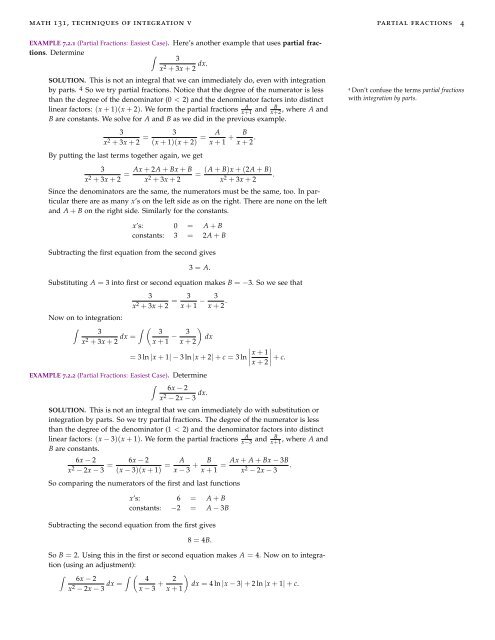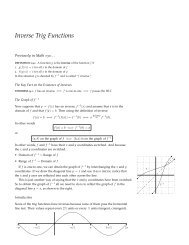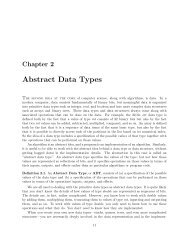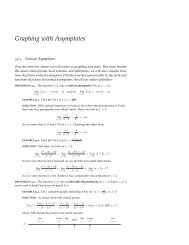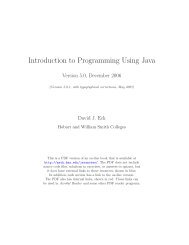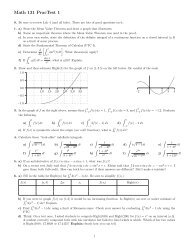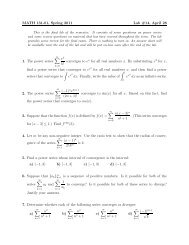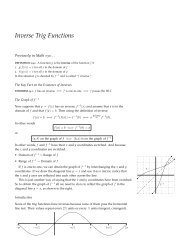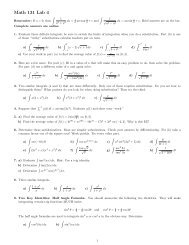Class Notes Day 26 on Partial Fractions
Class Notes Day 26 on Partial Fractions
Class Notes Day 26 on Partial Fractions
You also want an ePaper? Increase the reach of your titles
YUMPU automatically turns print PDFs into web optimized ePapers that Google loves.
math 131, techniques of integrati<strong>on</strong> v partial fracti<strong>on</strong>s 4<br />
EXAMPLE 7.2.1 (<strong>Partial</strong> Fracti<strong>on</strong>s: Easiest Case). Here’s another example that uses partial fracti<strong>on</strong>s.<br />
Determine<br />
∫<br />
3<br />
x 2 + 3x + 2 dx.<br />
SOLUTION. This is not an integral that we can immediately do, even with integrati<strong>on</strong><br />
by parts. 4 So we try partial fracti<strong>on</strong>s. Notice that the degree of the numerator is less<br />
than the degree of the denominator (0 < 2) and the denominator factors into distinct<br />
A<br />
linear factors: (x + 1)(x + 2). We form the partial fracti<strong>on</strong>s x+1 and x+2 B , where A and<br />
B are c<strong>on</strong>stants. We solve for A and B as we did in the previous example.<br />
3<br />
x 2 + 3x + 2 = 3<br />
(x + 1)(x + 2) = A<br />
x + 1 + B<br />
x + 2 .<br />
By putting the last terms together again, we get<br />
3 Ax + 2A + Bx + B<br />
x 2 =<br />
+ 3x + 2 x 2 =<br />
+ 3x + 2<br />
(A + B)x + (2A + B)<br />
x 2 .<br />
+ 3x + 2<br />
Since the denominators are the same, the numerators must be the same, too. In particular<br />
there are as many x’s <strong>on</strong> the left side as <strong>on</strong> the right. There are n<strong>on</strong>e <strong>on</strong> the left<br />
and A + B <strong>on</strong> the right side. Similarly for the c<strong>on</strong>stants.<br />
4<br />
D<strong>on</strong>’t c<strong>on</strong>fuse the terms partial fracti<strong>on</strong>s<br />
with integrati<strong>on</strong> by parts.<br />
x’s: 0 = A + B<br />
c<strong>on</strong>stants: 3 = 2A + B<br />
Subtracting the first equati<strong>on</strong> from the sec<strong>on</strong>d gives<br />
3 = A.<br />
Substituting A = 3 into first or sec<strong>on</strong>d equati<strong>on</strong> makes B = −3. So we see that<br />
3<br />
x 2 + 3x + 2 = 3<br />
x + 1 − 3<br />
x + 2 .<br />
Now <strong>on</strong> to integrati<strong>on</strong>:<br />
∫<br />
∫ (<br />
3<br />
3<br />
x 2 + 3x + 2 dx = x + 1 − 3 )<br />
dx<br />
x + 2<br />
= 3 ln |x + 1| − 3 ln |x + 2| + c = 3 ln<br />
x + 1<br />
∣ x + 2 ∣ + c.<br />
EXAMPLE 7.2.2 (<strong>Partial</strong> Fracti<strong>on</strong>s: Easiest Case). Determine<br />
∫<br />
6x − 2<br />
x 2 − 2x − 3 dx.<br />
SOLUTION. This is not an integral that we can immediately do with substituti<strong>on</strong> or<br />
integrati<strong>on</strong> by parts. So we try partial fracti<strong>on</strong>s. The degree of the numerator is less<br />
than the degree of the denominator (1 < 2) and the denominator factors into distinct<br />
linear factors: (x − 3)(x + 1). We form the partial fracti<strong>on</strong>s<br />
B are c<strong>on</strong>stants.<br />
6x − 2<br />
x 2 − 2x − 3 = 6x − 2<br />
(x − 3)(x + 1) = A<br />
x − 3 +<br />
B<br />
x + 1<br />
So comparing the numerators of the first and last functi<strong>on</strong>s<br />
x’s: 6 = A + B<br />
c<strong>on</strong>stants: −2 = A − 3B<br />
Subtracting the sec<strong>on</strong>d equati<strong>on</strong> from the first gives<br />
8 = 4B.<br />
A<br />
x−3 and<br />
B<br />
x+1<br />
Ax + A + Bx − 3B<br />
=<br />
x 2 .<br />
− 2x − 3<br />
, where A and<br />
So B = 2. Using this in the first or sec<strong>on</strong>d equati<strong>on</strong> makes A = 4. Now <strong>on</strong> to integrati<strong>on</strong><br />
(using an adjustment):<br />
∫<br />
∫ (<br />
6x − 2<br />
4<br />
x 2 − 2x − 3 dx = x − 3 + 2 )<br />
dx = 4 ln |x − 3| + 2 ln |x + 1| + c.<br />
x + 1


